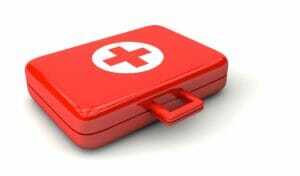 A basic emergency kit is an essential safety precaution that many of us take for granted. We all know that it’s important to be prepared in case of an emergency, especially here in South Florida where hurricanes and rising sea levels can cause disasters and flooding throughout the year, but chances are that few of us actually have a basic emergency kit ready to go.
A basic emergency kit is an essential safety precaution that many of us take for granted. We all know that it’s important to be prepared in case of an emergency, especially here in South Florida where hurricanes and rising sea levels can cause disasters and flooding throughout the year, but chances are that few of us actually have a basic emergency kit ready to go.
This should be a kit that is accessible to all family members, and is portable enough to be able to grab and go if needed. When disaster strikes, you want to make sure you have the essentials to help get you and your family to safety.
Food and water are absolutely vital in an emergency kit, but there are some items in addition to these that you should have available to use at all times.
7 Emergency Kit Essentials
1. Flashlight and Batteries
It’s best to have a couple different types of flashlights. A battery-operated flashlight is always nice to have, but it may also be beneficial to have another one that is run by solar, hand crank, or other power sources. Regardless of the type of flashlight you choose, you should always have different sizes of batteries on hand, including extras for your light source, but batteries that you may need for other items.
2. First Aid Kit
This is your kit within a kit, but it should be packed full of first aid items you may need, at least in the short term. Consider adding adhesive bandages of various sizes and wrap bandages in case of a sprain. Make sure you also have antibacterial ointments, alcohol wipes for cuts, gauze, and aspirin as well. If there are any special medications you use regularly, consider including those in your first aid kit.
3. Portable Cell Phone Charger
Make sure your chargers are fully charged so that if there is an issue, and electrical power sources are unavailable, you have additional chargers for your cell phones. Extra plugs and wires may also be good to include, but during an emergency, it’s not always guaranteed that there will be power available to plug the phone into a wall.
4. Emergency Contact Information
Not everyone has phone numbers memorized these days, so it’s important to write down important phone numbers and addresses in case you need them during an emergency. This could also include the numbers for your local hospital and police non-emergency numbers. You may also want to include your attorney’s information in the contact document in the event that you need to resolve a legal issue in the wake of an emergency. Ensure that each family member has a copy of this document if needed. Also, store this information in a waterproof bag.
5. Extra Sets of Keys for House & Car
It might be a good idea to keep your spare keys in your emergency kit. That way if you somehow lose your primary set of keys, you always know where to find a spare.
6. Sound/Light Makers Such as a Whistle
Make sure you also have to a way to alert others of distress if power and cell phones are down. This could be a flare, a whistle or a noise-making machine. In the event that electricity is out, and you need to alert authorities, neighbors, or you become stranded in your vehicle, these are items that may help you draw attention to yourself.
7. Medication and Sanitation/Personal Hygiene Items
Your emergency kit should also include medication that you may need in a hurry such as an EpiPen or an antihistamine. You should also include antibacterial lotion and any other sanitation items in your kit, as well as any feminine or other types of hygiene needs. If there is an event such as a hurricane or major flooding, and there is damage around the city, there is no guarantee that stores will open before you will need these important items.
Preparing for an emergency is always the best policy, especially because many times these types of events come up unexpectedly. Be prepared and stay safe!
References:
Get a Kit. (n.d.). Retrieved January 09, 2018, from http://redcross.org/get-help/prepare-for-emergencies/be-red-cross-ready/get-a-kit


